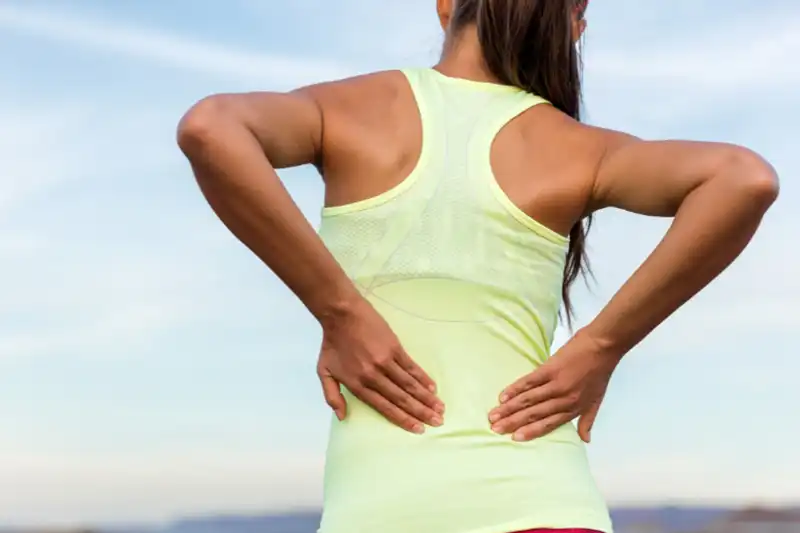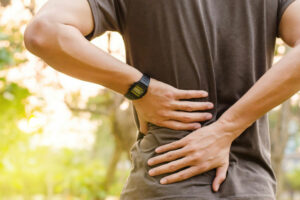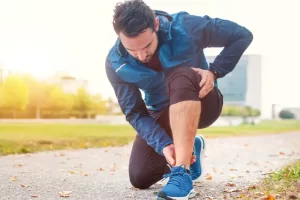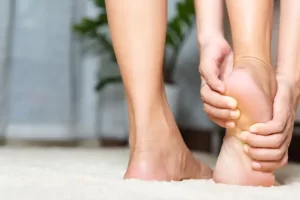Our backs go through a lot – bending, lifting, slouching – so it’s no surprise they can start to complain. The lower back, or lumbar region, handles a big load during everyday activities like walking, running, and lifting. The strength and flexibility of your lower back come from the muscles supporting the spine and core as well as the tough ligaments holding the vertebrae together. But the demands of daily life can push these tissues to their limits. Too much pressure can cause ligaments to stretch or tear (a sprain) or muscles and tendons to stretch or tear (a strain).
Whether it’s a sprain or a strain, the bottom line is if your back hurts, it hurts. At Ponte Vedra Spine & Pain Center, we get it. We know that getting the right support, empathy, and information is crucial to navigating lower back discomfort. Because when it comes to your back, a little understanding can make a big difference for pain management in Ponte Vedra, FL.
What Is A Lower Back Strain?
A lower back strain occurs when the muscles or tendons in your lower back stretch, resulting in a tear or spasm in the muscle. This injury is often linked to overexertion, sudden movements, or lifting incorrectly. Lower back strains are categorized into three levels: minor (first degree), moderate (second degree), and severe (third degree).
- First-degree lower back strains are the mildest, involving overstretching or minor tearing of muscle fibers. You can still move, but there might be some lower back discomfort, especially with increased activity.
- Second-degree lower back muscle strains are partial tears of muscles, leading to more pronounced symptoms. Limited movement in all directions may occur due to muscle spasms, and the pain is more significant.
- Third-degree lower back muscle strains are the most severe, with a complete tear of one or more muscles, potentially at the musculotendinous junction, causing increased pain during any attempted movement.
Understanding the degrees of lower back strains is crucial for effective pain management and treatment. Armed with this knowledge, both you and Dr. Loch can find the right care for your lower back strains and help you regain the active lifestyle you deserve.
What Causes Lower Back Strains?
Lower back strains can happen suddenly or develop gradually due to muscle tearing. Various factors contribute to these strains, including lifting too much weight, participating in physically demanding sports, overusing muscles, and twisting or bending improperly. These situations stretch ligaments beyond their normal range, causing injury and resulting in sharp, deep, burning, stabbing, or dull pain.
Typically, lower back pain lasts a few weeks, but it can become chronic if healing is hindered or a repeat injury occurs. Age is a notable factor, especially for those aged 30 and above who often experience their first episode of lower back pain, however, this can happen to anyone at any time. Besides age, common causes of lower back strains include:
- Extreme physical exertion
- Weak back extensor muscles
- Falling
- Poor posture
- Lack of physical fitness
- Obesity
- Emotional stress or tension
- Severe coughing
- Lack of core strength
Understanding the influence of each factor on lower back strains is essential, given the various causes of this condition. At Ponte Vedra Spine & Pain Center, we emphasize the importance of personalized care. By pinpointing the specific causes of your lower back discomfort, we adopt a customized approach that enhances the accuracy of diagnosis and treatment. Our goal is to provide you with the most effective care, guiding you toward a life free from pain.
What Are The Symptoms of Lower Back Strains and How Are They Diagnosed?
Typically, lower back sprains result in a widespread, dull ache throughout the lower back. This lower back discomfort may be localized on one side. You might experience difficulty bending your back or standing up fully straight. Occasionally, muscle spasms may occur, particularly during movement or while sleeping, turning the back muscles into tense and painful knots. Common symptoms of lower back sprains can include:
- Low back pain that may radiate into the buttocks, but does not affect the legs
- Stiffness in the low back area, restricting range of motion
- Inability to maintain normal posture due to stiffness and/or pain
- Muscle spasms either with activity or at rest
- Pain that persists for a maximum of 10-14 days
Given the similarity between lower back strain symptoms and more serious conditions, seeking a doctor’s evaluation is crucial. Mild strains are typically diagnosed through a review of medical history and symptoms. Dr. Loch will conduct a thorough exam and tests to rule out injuries involving the spine, nerve roots, intervertebral discs, and ligaments for an accurate low back strain diagnosis.
Common diagnostic tests for lower back strains at Ponte Vedra Spine & Pain Center include:
- X-rays
- MRIs (Magnetic Resonance Imaging)
- CT scans
How Are Lower Back Strains Treated?
Treating lower back strains usually happens in two phases. In the first phase, the focus is on easing pain and muscle spasms. This might include rest, using ice packs, and applying compression (pressure), especially in the initial 24 to 48 hours post-injury. Over-the-counter nonsteroidal anti-inflammatory drugs like ibuprofen (Motrin®) could be suggested to help with pain and swelling. After the initial 24 to 48 hours, gradually returning to regular activities is recommended. Prolonged bed rest or immobility only makes symptoms last longer and delays recovery. Most people with lower back strain symptoms see improvement in about 2 weeks. If symptoms persist beyond this period, additional treatment may be necessary. Common treatments for lower back strains at Ponte Vedra Spine & Pain Center include:
Ice for Swift Relief:
- Apply ice to your back immediately after an injury to reduce pain and swelling.
- Ice for 20-30 minutes every 3-4 hours for the first 2-3 days.
- Continue to ice your back after physical activities.
Introduce Heat Gradually:
- Use heat on your back only after 2-3 days of initial icing once the swelling has subsided.
- Options include an electric heating pad, a hot water bottle, or a relaxing soak in a hot bath.
Pain Management with Caution:
- Take medications as advised by your doctor.
- Non-steroidal anti-inflammatory drugs (NSAIDs) like Advil, Aleve, or Motrin can help with pain and swelling but should be used occasionally to minimize potential side effects.
- Prescription muscle relaxants may be necessary under your doctor’s guidance.
Consider Support Options:
- Consult your doctor or therapist before considering a back belt or girdle for added support.
- Use support devices short-term only or when engaging in heavy or repetitive lifting.
Embrace Physical Therapy:
- Follow your doctor’s recommendation for physical therapy to strengthen your back.
- Avoid prolonged bed rest; staying active can contribute to recovery.
Strengthen Core Muscles:
- Maintain good muscle tone in your abdominal and lower back muscles to support your overall back health.
Can I Prevent Lower Back Strains?
While it’s challenging to prevent all back injuries, the good news is that the chances of a full recovery from a lower back strain are excellent. Over 90% of people bounce back completely within a month after experiencing a lower back strain. At home, heat and ice treatments are suggested on an as-needed basis to manage sudden flare-ups of low back pain, coupled with anti-inflammatory medications, physical therapy, and rest. Common prevention practices for lower back strains at Ponte Vedra Spine & Pain Center include:
Fuel Your Body Right:
- Consume a nutritious, well-balanced diet to promote strong bones and muscles.
Maintain a Healthy Weight:
- Keep your weight in check to alleviate added stress on the lower back structures.
Stay Active and Limber:
- Incorporate regular exercise, including stretching, to maintain flexible joints and healthy muscles.
Prevent Falls with Safety Measures:
- Avoid falls by wearing properly fitting shoes and keeping walkways clear of clutter.
Practice Good Body Mechanics:
- When sitting or standing, maintain a straight back and shoulders.
- Sit with knees bent and feet flat on the floor.
- Avoid over-reaching and twisting movements.
- When lifting, bend your knees, utilizing strong leg muscles to balance the load.
Quit Smoking for Better Circulation:
- Stop smoking, as nicotine can hinder blood flow to the muscles, impacting overall back health.
Kind Approach, Sustained Relief: Lower Back Strain Pain Management in Ponte Vedra, FL
We know dealing with lower back strains can pose challenges, but at Ponte Vedra Spine & Pain Center, we provide compassionate assistance and individualized care that suits your specific needs. While each recovery path is unique, substantial improvement is within reach. Don’t let that strain in your back become a strain on your life, schedule an appointment with Dr. Eli Loch today!









